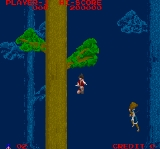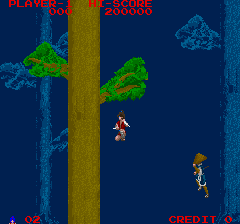
Legend of Kage
Encyclopedia
The Legend of Kage is a 1985
arcade game
by Taito
and was released for several contemporary home computer
systems in 1986
.
ninja
named Kage ("Shadow") on the mission to rescue Princess Kiri (Kirihime) from the villains Yoshi (Yoshiro Yukikusa) and Yuki (Yukinosuke Kiri). Kage must fight his way through the forest, along the secret passageway, up the fortress wall and through the castle, rescuing her two times (three in the NES version) in order to win the game. Each time the princess is rescued, the seasons change in the game.
 The player is armed with a kodachi
The player is armed with a kodachi
shortsword and an unlimited amount of shuriken
. Grabbing a crystal ball causes Kage's clothes to change to the next level in colour and thereby attain certain powers (bigger shuriken and/or faster speed); if Kage is hit while in green or orange clothes, he does not die but revert to his normal red clothes. Grabbing a scroll
causes Kage to stand still and meditate for several seconds while approaching enemies drop to the ground dead (note that although the scrolls appear in the arcade version, the crystal balls do not).
's Virtual Console
in Japan
on December 19, 2006, and in the United States
on February 19, 2007. The arcade version also appears in the compilation title Taito Legends 2
.
A 3D
remake
of the arcade game along the original arcade version is included in the 2006 compilation Taito Legends Power Up for the PSP
.
A sequel
titled The Legend of Kage 2
was released in 2008 for the Nintendo DS
.
Connections to the other Taito games
1985 in video gaming
-Notable releases:* Brøderbund releases Where in the World is Carmen Sandiego?, the first game of the prolific Carmen Sandiego series* Nintendo releases Super Mario Bros. on September 13, 1985, which eventually sells 40 million copies making it the best-selling video game of all time until 2008.*...
arcade game
Arcade game
An arcade game is a coin-operated entertainment machine, usually installed in public businesses such as restaurants, bars, and amusement arcades. Most arcade games are video games, pinball machines, electro-mechanical games, redemption games, and merchandisers...
by Taito
Taito Corporation
The is a Japanese publisher of video game software and arcade hardware wholly owned by publisher Square Enix. Taito has their headquarters in the Shinjuku Bunka Quint Building in Yoyogi, Shibuya, Tokyo, sharing the facility with its parent company....
and was released for several contemporary home computer
Home computer
Home computers were a class of microcomputers entering the market in 1977, and becoming increasingly common during the 1980s. They were marketed to consumers as affordable and accessible computers that, for the first time, were intended for the use of a single nontechnical user...
systems in 1986
1986 in video gaming
-Events:-Notable releases:*Namco releases Sky Kid Deluxe, Hopping Mappy, Toy Pop, The Return of Ishtar, which is the sequel to Tower of Druaga, Genpei Tōma Den, and Rolling Thunder....
.
Story
The player takes role of the young IgaIga-ryu
Iga-ryū 伊賀流 is a historical school of ninjutsu. It became one of the two most well-known ninja schools in Japan, along with the Kōga-ryū. The Iga-ryū originated in the Iga Province in the area around the towns of Iga and Ueno...
ninja
Ninja
A or was a covert agent or mercenary of feudal Japan specializing in unorthodox arts of war. The functions of the ninja included espionage, sabotage, infiltration, and assassination, as well as open combat in certain situations...
named Kage ("Shadow") on the mission to rescue Princess Kiri (Kirihime) from the villains Yoshi (Yoshiro Yukikusa) and Yuki (Yukinosuke Kiri). Kage must fight his way through the forest, along the secret passageway, up the fortress wall and through the castle, rescuing her two times (three in the NES version) in order to win the game. Each time the princess is rescued, the seasons change in the game.
Gameplay

Kodachi
A , literally translating into "small or short tachi ", is a Japanese sword that is too long to be considered a dagger but too short to be a long sword...
shortsword and an unlimited amount of shuriken
Shuriken
A shuriken is a traditional Japanese concealed weapon that was generally used for throwing, and sometimes stabbing or slashing...
. Grabbing a crystal ball causes Kage's clothes to change to the next level in colour and thereby attain certain powers (bigger shuriken and/or faster speed); if Kage is hit while in green or orange clothes, he does not die but revert to his normal red clothes. Grabbing a scroll
Scroll
A scroll is a roll of parchment, papyrus, or paper, which has been drawn or written upon.Scroll may also refer to:*Scroll , the decoratively curved end of the pegbox of string instruments such as violins...
causes Kage to stand still and meditate for several seconds while approaching enemies drop to the ground dead (note that although the scrolls appear in the arcade version, the crystal balls do not).
Re-releases
The NES version was re-released on the WiiWii
The Wii is a home video game console released by Nintendo on November 19, 2006. As a seventh-generation console, the Wii primarily competes with Microsoft's Xbox 360 and Sony's PlayStation 3. Nintendo states that its console targets a broader demographic than that of the two others...
's Virtual Console
Virtual console
A virtual console – also known as a virtual terminal – is a conceptual combination of the keyboard and display for a computer user interface. It is a feature of some operating systems such as UnixWare, Linux, and BSD, in which the system console of the computer can be used to switch between...
in Japan
Japan
Japan is an island nation in East Asia. Located in the Pacific Ocean, it lies to the east of the Sea of Japan, China, North Korea, South Korea and Russia, stretching from the Sea of Okhotsk in the north to the East China Sea and Taiwan in the south...
on December 19, 2006, and in the United States
United States
The United States of America is a federal constitutional republic comprising fifty states and a federal district...
on February 19, 2007. The arcade version also appears in the compilation title Taito Legends 2
Taito Legends 2
Taito Legends 2 is the sequel to Taito Legends and is a follow-up collection of 39 Taito arcade games for the PlayStation 2, Xbox and PC....
.
Legacy
Follow-upsA 3D
3D computer graphics
3D computer graphics are graphics that use a three-dimensional representation of geometric data that is stored in the computer for the purposes of performing calculations and rendering 2D images...
remake
Remake
A remake is a piece of media based primarily on an earlier work of the same medium.-Film:The term "remake" is generally used in reference to a movie which uses an earlier movie as the main source material, rather than in reference to a second, later movie based on the same source...
of the arcade game along the original arcade version is included in the 2006 compilation Taito Legends Power Up for the PSP
PlayStation Portable
The is a handheld game console manufactured and marketed by Sony Corporation Development of the console was announced during E3 2003, and it was unveiled on , 2004, at a Sony press conference before E3 2004...
.
A sequel
Sequel
A sequel is a narrative, documental, or other work of literature, film, theatre, or music that continues the story of or expands upon issues presented in some previous work...
titled The Legend of Kage 2
The Legend of Kage 2
Critical reception has been mixed. The Legend of Kage 2 has been noted for its difficulty, which was reported to rise considerably after the first level. The game has also been praised for the well-designed boss fights, and crisp, vivid art, but was also criticized for the lack of detail in the...
was released in 2008 for the Nintendo DS
Nintendo DS
The is a portable game console produced by Nintendo, first released on November 21, 2004. A distinctive feature of the system is the presence of two separate LCD screens, the lower of which is a touchscreen, encompassed within a clamshell design, similar to the Game Boy Advance SP...
.
Connections to the other Taito games
- The 1984 laserdisc video gameLaserdisc video gameA laserdisc video game is an arcade game that uses pre-recorded video played from a laserdisc, either as the entirety of the graphics, or as part of the graphics.-History:...
Ninja HayateNinja Hayateis a laserdisc arcade game first developed and released by Taito in Japan only. The game became better known when it was released in North America and Europe for the Sega Mega-CD as Revenge of the Ninja.- Plot :...
features a very similar scenario of a young ninja (who even looks like Kage) attempting to rescue a kidnapped princess. - The 1989 game Demon SwordDemon Swordis an action video game developed by Taito in 1989 for the Nintendo Entertainment System. The caption on the box says to "Release the Power". This is consistent with the game's method of powering up the character's abilities.-Comparison to other media:...
is similar in gameplay to The Legend of Kage.
External links
- The Legend of Kage at GameFAQsGameFAQsGameFAQs is a website that hosts FAQs and walkthroughs for video games. It was created in November 1995 by Jeff "CJayC" Veasey and was bought by CNET Networks in May 2003. It is currently owned by CBS Interactive. The site has a database of video game information, cheat codes, reviews, game saves,...
- Arcade flyer

